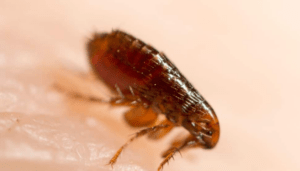When you have bites on your skin but don’t see any signs of bugs, it can be puzzling and frustrating.
Keep in mind that insects like bed bugs are hiding most of the time, and rarely come out during the day. Therefore even if you don’t see physical bugs, you should look for evidence of insects like bed bugs.
Here are a few common signs of bed bugs to look for:
Bloodstains on bedding: After feeding, bed bugs may leave behind small bloodstains on your sheets or pillowcases.
Dark spots or fecal stains: Bed bugs leave dark, rust-colored stains on bedding, mattresses, or nearby furniture. These stains are the bugs’ excrement and are often found in clusters or streaks.
Eggshells and molted skins: As bed bugs go through their life cycle, they shed their skin. You may find small, translucent, empty shells or molted skins in the areas where they hide.
Musty odor: Some people describe the presence of bed bugs as having a sweet, musty odor. If you notice an unusual smell in your bedroom or near your bedding, it could be a sign of an infestation.
Page Contents:
Where Bed Bugs Hide
Bed bugs are elusive pests that are skilled at hiding in various places, often in close proximity to their human hosts. These nocturnal insects seek out dark, undisturbed areas during the day and emerge at night to feed on blood.
Some of these hiding places include cracks, crevices, and narrow spaces, taking advantage of their flat bodies to squeeze into tight spots.
Though the most typical hiding spots for bed bugs include mattress seams, box springs, and bed frames, as they provide easy access to their preferred hosts. They can also be found in upholstered furniture, such as couches and chairs, where they conceal themselves in seams and cushion crevices.
Other less common hiding places include cracks in walls, floorboards, electrical outlets, and even behind loose wallpaper.
You should keep in mind that bed bugs are adaptable creatures and can hide in a variety of locations, making detection and eradication challenging without professional assistance.
Still See Bites but Don’t See Any Signs of Bed Bugs?
There are several possible explanations for what these bites could be if you don’t see any signs of bed bugs in your home.
1. Delayed reaction: Sometimes, insect bites may not become noticeable until several hours or even days after the actual bite occurred. The initial reaction might be mild, so you might have been bitten somewhere other than where you slept last night.
2. Allergic reaction: It’s possible that you’re experiencing an allergic reaction to something other than insect bites. Allergies to certain foods, medications, or even environmental factors can manifest as skin rashes or hives that may resemble bug bites.
3. General skin irritation: Other factors like fabric allergies, contact dermatitis, or irritants in your environment (such as certain soaps, lotions, or chemicals) can cause skin irritation and lead to red, itchy bumps that resemble insect bites.

4. Psychological factors: In some cases, people may experience sensations of being bitten without any actual physical cause. Conditions such as delusional parasitosis or formication can create the illusion of insect bites on the skin, even in the absence of real insects.
Delusional parasitosis is a psychiatric disorder characterized by a false belief that one is infested with parasites despite a lack of evidence. Individuals with this condition often experience persistent itching, and sensations of crawling or biting, and may engage in compulsive behaviors to alleviate their perceived infestation.
If you continue to experience unexplained bites or are concerned about your symptoms, it’s recommended to consult with a healthcare professional or a dermatologist who can evaluate your condition more thoroughly.
They can help determine the cause and provide appropriate advice or treatment.
5 Other Bugs That Bite at Night
1. Mosquitoes: While mosquitoes are active during the day as well, certain species, like the Aedes and Culex mosquitoes, are known to be more active and aggressive during nighttime. They are attracted to body heat and the carbon dioxide we exhale, and their bites can cause itching and discomfort.
2. Fleas: Fleas are typically associated with pets, but they can also bite humans. They are most active during the night and can infest bedding, carpets, or furniture, causing itchy, red bites.

3. No-see-ums (Biting Midges): These tiny flies, also known as sandflies or midges, are active primarily during the evening and night hours. They are found in coastal areas, near lakes or marshes, and their bites can be quite irritating, causing intense itching and welts.
4. Ticks: While ticks are generally associated with outdoor activities, some species, like the brown dog tick and the deer tick, are known to bite humans at night. Ticks can carry diseases, so it’s important to take precautions when spending time in tick-infested areas.
5. Chiggers: Chiggers are mites that tend to bite during the night, especially in grassy or wooded areas. Their bites often occur around areas where clothing fits tightly against the skin, such as ankles, waistbands, or underarms. Chigger bites can cause intense itching.
Can Skin Conditions Resemble Bug Bites?
Yes, certain skin conditions can resemble bug bites, causing confusion in determining the cause of the symptoms. Skin conditions such as hives (urticaria) and allergic reactions can produce raised, red welts that closely resemble insect bites. Hives are often itchy and can appear suddenly, varying in size and shape.
Allergic reactions to certain foods, medications, or environmental triggers can lead to similar skin reactions, adding to the confusion.
Additionally, conditions like eczema and psoriasis can sometimes present as small, raised bumps that may be mistaken for bug bites. Furthermore, some infestations like scabies can also result in a rash that resembles bug bites. Scabies is caused by microscopic mites that burrow into the skin, leading to an itchy rash characterized by small red bumps or blisters. These can be mistaken for insect bites, especially when they appear in clusters or in areas where the mites have burrowed.
A proper medical evaluation is essential to identify the underlying cause and provide appropriate treatment for any skin condition that resembles bug bites.
Still Having Problems? Get Peace of Mind From a Professional
If you still suspect a pest infestation, it might be a good idea to get peace of mind and call a pest control professional.
They possess the expertise, tools, and knowledge to accurately identify and address the issue. Swift action can help prevent the infestation from worsening, minimize property damage, and safeguard your health and well-being.
Don’t hesitate to reach out to a trusted pest control professional who can provide effective solutions tailored to your specific situation.




